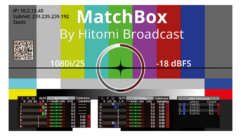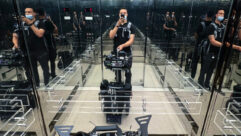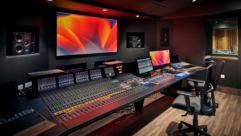Gold Is Where You Find It
Aug 1, 2002 12:00 PM,
Pete Putman
SHORTLY AFTER RETURNING FROM INFOCOMM 2002 in Las Vegas, I began sifting through my notes and a stack of press kits, trying to make sense of the show. There were plenty of exhibitors, though attendance was said to be down — possibly as low as 16,000 to 17,000, according to some floor chatter. Even so, ICIA seminar registrations were at an all-time high, exceeding 8,000 for a multitude of offerings. My two seminars on flat-screen technology and digital TV attracted more than 150 attendees, consistent with past years.
Many people are getting weary of constantly traveling to Las Vegas for trade shows. InfoComm has been a little hampered the past two years in following NAB by a scant six weeks. For some end-users, a return trip to Nevada during the blazing heat of mid-June just doesn’t hold much appeal. That will change next year as the show returns to Orlando, Florida, and then it moves to a new venue in 2004 — Atlanta.
GOTTA CHECK ‘EM OUT
There were many products to view in the Sands Expo Center, but a lot of them were derivative, particularly in the interface category. The predictable was in evidence (lighter, brighter LCD and DLP projectors, networked A/V, more plasma and LCD monitors), but it took some work to dig out the truly neat products — those that broke significant price barriers, took technology another step further, or were simply innovative.
So rather than do a comprehensive review of the show, I’m going to highlight several products that were of greater-than-usual interest. Mind you, with 400-plus exhibitors and only three days, it’s hard to catch everything, so don’t be surprised if you saw something I didn’t.
I will start with Epson, which finally broke down and introduced a 16:9 native front LCD projector for home theater. Dubbed the TW100, this box is significant in that it breaks the $5,000 barrier for true HD-resolution imaging (1,280-by-720-pixel LCDs are used). Epson has always had excellent color management in its LCD projectors, and I had suggested on more than one occasion it branch into the home-theater market. Done!
Kramer Electronics unveiled the VP-723DS, a do-it-all seven-input seamless switcher and scalar that converts video and RGB signals from VGA to UXGA to eight output rates, three of which are DTV-compatible (480p, 720p, and 1,080i). Although this product by itself was pretty interesting, the price was astoundingly low for this feature set and will be announced publicly soon.
Sharp and NEC Technologies were demonstrating 802.11b wireless but took it to another level by adopting a remote desktop protocol — whatever you had displayed on your notebook or desktop PC would appear on the wireless-enabled projector. Many companies are offering 802.11b connectivity, but its use is limited to PowerPoint or JPEG files. Not any more.
Sharp’s demonstration took place with the high-tech PG-M25X microportable XGA LCD projector, which features some pretty cool case styling. It and its sibling, the PG-M20X, are rated at 1,900 lumens brightness and weigh 5.8 pounds. NEC’s demo incorporated the new SVGA LT220, XGA LT240, and XGA LT260 DLP microportables, which crank out 2,000, 1,500, and 2,100 lumens, respectively.
Mitsubishi and Christie showed some respect for their past by introducing LAN-connectivity solutions that are backward-compatible with their older projectors. How’d they do it? Simple. All it takes is their proprietary converters to translate IP packets to RS-232C protocols, and you are in business. Their newer projectors are completely LAN-ready, but it’s nice to know someone is looking out for your equipment investment.
The Mitsubishi system goes by the name Projector View and was running on several new boxes, including the impressive new XL30 Color View. It specs out at 3,000 lumens with XGA resolution and weighs 13 pounds. Christie’s ChristieNet works with a pile of DLP and LCD products; among the latter were the new Vivid LX33 (3,300 lumens, XGA, 17.4 pounds) and the Vivid LX41 (4,100 lumens, XGA, 18.5 pounds).
Clarity demoed the SignPost, a self-contained 60-inch portrait-mode LCD. It uses 1,024-by-576 masked AM-LCD panels and occupies only 27 inches. Clarity is said to have fine-tuned the dichroics to achieve a close match to SMPTE “C” phosphors, and the video and still images being shown on the SignPost supported that claim with rich, saturated reds and greens.
Daewoo, ViewSonic, Optoma, and BenQ certainly drew some attention by aggressively pricing their new plasma products. Daewoo’s DSP-4280GM is a 16:9, 852-by-480 panel that weighs 66 pounds and will be less than $5,000, as will ViewSonic’s VPW425 ($4,995). ViewSonic also announced the VPW505, a 50-inch panel offered for $9,995. That makes it the first retailer to break that psychological $10,000 MSRP barrier.
Optoma’s PD46 panel (originally a Mitsubishi invention) is also 16:9 with 852-by-480 resolution and weighs 75 pounds without the stand. Optoma also had a unique 17-inch, 16:9 LCD monitor, the LD17. It features a 1,280-by-768-pixel matrix and will retail for $1,495. Finally, BenQ announced two plasma monitors (though three were seen in the company’s booth handouts), the 42-inch 4:3 PDP7843e ($6,495) and 46-inch, 16:9 PDP46W1 ($5,495). Let the plasma price wars begin!
The coolest thing in Sony’s booth was also one of the smallest. The NSP-100 Network Player is a silicon storage unit that can download audio, video, text, and graphics over IP networks and store them for later playback on products such as Sony’s PlasmaPro monitors. It weighs 2.2 pounds, and a 40 GB storage capacity is standard, employing MPEG-2 for playback. (One Sony executive was keeping close tabs on its whereabouts.)
There are LCD monitors, and then there’s Samsung’s 241MP LCD monitor. This 24-inch flat-screen has an almost unbelievable 1,920-by-1,200-pixel native resolution, weighs 49.6 pounds, and will accept just about any RGB or video signal you connect to it. You can use it as a workstation monitor for video production, and there’s even a built-in RF tuner (NTSC ready). There’s also a 21-inch version, the 1,600-by-1,200 211MP, with many of the same features.
Rainbow Displays showed there’s more than one way to achieve big, flat screens by stitching together smaller LCD panels. The result? The Model 3750 16:9 LCD, which measures 37 inches and sports 852-by-480-pixel resolution. It weighs less than 50 pounds, is only 4.5 inches thick, and handles VGA to XGA, composite, S-video, and component video signals.
A company that shall remain unnamed had an off-site demo of a breakthrough three-chip XGA DLP installation projector that weighs less than 50 pounds (without lens). The secret? Using UHP lamps to reduce weight and power supply requirements. Not everyone needs xenon arc lamps for imaging. The price is competitive with large LCD installation projectors, and you’ll hear all about it when the final announcement is made in September 2002.
AS EXPECTED
Hitachi joined the large plasma panel grouping with its CMP5000WXU, a 50-inch design with 1,280-by-768 resolution. … NEC Technologies incorporated the newest Texas Instruments dark metal DMD chips into its new Nighthawk SX4000D, SX6000D, and SX10000D, as well as its TriDigital HD4K, HD6K, and HD10K. … Sony finally announced retail pricing for its 50-inch PFM50C1 plasma at $12,499 — just below NEC’s $12,995 for the 50MP2. … Pioneer showed a 61-inch panel, most likely an NEC product. … Panasonic is now a member of the 42-inch wide XGA plasma club with its TH-42PWD5UY panel. … Extron continues to expand its Crosspoint switcher line with 24-by-12, 24-by-24, 32-by-16, and 32-by-32 models. … Barco joins Sanyo and Christie in offering a UXGA (1,600-by-1,200) resolution front LCD projector, the UltraReality 7000. Barco also unveiled an SXGA version of its IQ300, the IQR300. Barco’s seamless switcher is incorporated into both models. … Fujitsu made a minor course correction by adding the 50-inch PDS-5003 plasma monitor, which now has built-in audio amplifiers, unlike the earlier PDS-5001. … Toshiba announced two plasma panels, the 42-inch 42HP82 (852 by 480 with DVI) and the 50-inch 50HP82 (1,365 by 768, also comes with DVI).
RAISED EYEBROWS
Sanyo showed a prototype compact SXGA LCoS front projector (1,365 by 1,024), but no model or release date yet… . Folsom Research is apparently building its own switchers and no longer uses the Vista Controls versions… . Optoma had a pair of DLP rear-projection TVs in 50- and 65-inch sizes using 1,280-by-720 DMDs that were less than 22 inches deep… . Samsung showed its 43- and 50-inch, 1,280-by-720 DLP RPTVs with 13 inches of depth, a 2-by-2 video/data wall using 1,280-by-720 DMDs, and its prototype 40-inch, 16:9 AM-LCD monitor… . NEC-Mitsubishi had a new, unnamed 30-inch multimedia LCD monitor up for viewing… . Aurora Multimedia now offers a desktop integrated NTSC tuner, video scalar, switcher, and PIP processor in a desktop cabinet, called the Xtune. A digital version for 8VSB and QAM is in the works… . Communications Specialties continues to expand its Fiberlink line, this time with a full-bandwidth component video and audio version (7070 Series) and even an S-video version (7060 Series)… . AVerMedia showed a pair of supertiny documents cameras, the AverVision 300 and 110. Both weigh less than four pounds… . InFocus had a pair of neat projector designs, including the 2.4-pound LP70 (1,100 lumens, XGA DLP) and the desktop/installation LP790 (3,000 lumens, XGA LCD, LAN-capable, DVI with HDCP)… . Analog Way has now expanded its Graphic Switcher II to 16 possible RGB and video inputs… . Digital Projection announced a price reduction on the Highlite 4100gv (XGA DLP, 3,500 lumens) to less than $30,000 without lens.
WHAT’S TO COME
With the decline in corporate profits, the projector business took a bit of a hit in late 2001 and into Spring 2002. Look for future growth in this market to come from the education market (why do those folks keep buying SVGA projectors?) as well as home theater. There were indications at the Projector Industry Summit Conference, held in conjunction with InfoComm, that a lot of potential exists in small companies (as many as 50 employees) for compact, network-capable XGA projectors.
Still, there remains a fair amount of resistance to using them as much as projector manufacturers would like. A recent InFocus study showed that many end-users still think projectors are too complicated to operate (they’re actually less complicated than microwave ovens), are still a bit too expensive, and could be a bit smaller. (A bit more than two pounds isn’t light enough? You have to be kidding.)
Participants in the InFocus survey would also like to move beyond PowerPoint, which I assume means they’d like to switch to Linux-based presentation software or they’re really leaning toward the remote active desktop setup that Sharp and NEC were demonstrating. As for the price issue, the day of a microportable $995 SVGA projector with 1,000-plus lumens isn’t too far off — maybe that’ll appear at InfoComm 2003, most likely introduced by one of the Taiwanese manufacturers that wants to make a big dent in market share.










